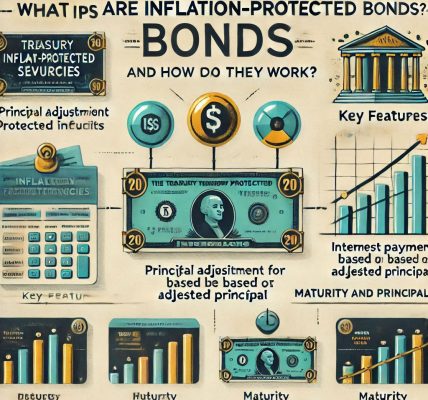When interest rates are low, many investors are left wondering if bonds are still a good investment option. Traditionally, bonds are seen as a safe haven for those seeking steady income with relatively lower risk, but in a low-interest-rate environment, the dynamics of bond investing can change. In this blog, we’ll explore whether bonds are a suitable investment during periods of low interest rates, and if so, how to approach bond investing to maximize returns.
Understanding Bonds and Interest Rates
To understand the impact of low-interest rates on bond investments, it’s important to first grasp how bonds work. Bonds are debt securities issued by governments or corporations, and they pay interest (also known as a coupon) to bondholders over a fixed period of time. The amount of interest paid is generally determined by the bond’s face value and the coupon rate, which is directly influenced by prevailing interest rates.
When interest rates are low, bond yields also tend to be lower. This means that new bonds issued during a low-interest-rate period will pay lower interest rates compared to bonds issued in a higher-rate environment. For investors looking for a predictable income stream, this can be a cause for concern.
Challenges of Bond Investing in a Low-Interest-Rate Environment
- Lower Yields: One of the most immediate effects of low interest rates is that newly issued bonds offer lower yields. For example, if you’re used to earning 5% on a bond and interest rates drop to 2%, you’re now only earning 2% on your investment, which may not meet your income needs.
- Reduced Income Potential: Low-interest rates mean lower coupon payments on bonds. If you’re relying on your bond portfolio for consistent income, a low-interest-rate environment may force you to find alternative sources of income or accept lower returns.
- Bond Prices and Duration: In a low-interest-rate environment, the prices of existing bonds tend to rise. When interest rates drop, older bonds with higher coupon rates become more valuable because they pay more interest compared to newly issued bonds. However, this can also increase the duration risk—meaning that longer-term bonds are more sensitive to interest rate changes. If interest rates rise again, the value of long-term bonds could fall sharply.
- Reinvestment Risk: Low rates also present a reinvestment risk. When your bonds mature or you receive interest payments, you may not be able to reinvest at a higher rate, as interest rates are lower. This means that over time, your portfolio could yield less than it did previously, reducing overall returns.
Opportunities for Bond Investors in a Low-Interest-Rate Environment
While the challenges are clear, low-interest rates don’t necessarily mean that bonds are a poor investment. In fact, there are several opportunities that can make bond investing still attractive in such an environment:
- Capital Appreciation: As mentioned earlier, bond prices tend to rise when interest rates fall. This presents an opportunity for bond investors to achieve capital gains. If you’re holding bonds issued before the rate drop, you may see their prices increase, allowing you to sell them for a profit. However, this depends on your investment horizon and the ability to predict market trends.
- Diversification Benefits: Bonds are often seen as a safe, income-generating asset class. They provide diversification benefits in a portfolio, especially when combined with riskier assets like stocks. Even in a low-interest-rate environment, having bonds in your portfolio can help reduce overall risk and stabilize returns.
- Bond-Laddering Strategy: One of the most effective strategies to manage the impact of low interest rates is bond laddering. A bond ladder is a portfolio strategy where bonds with different maturities are purchased. As the shorter-term bonds mature, the proceeds are reinvested into new bonds. This strategy helps mitigate reinvestment risk and can allow you to take advantage of future interest rate increases when they occur.
- TIPS (Treasury Inflation-Protected Securities): If inflation is a concern during a low-interest-rate period, consider investing in TIPS. These bonds are specifically designed to protect against inflation, as their principal value adjusts based on the Consumer Price Index (CPI). This makes them a valuable tool for investors who want to maintain purchasing power during periods of low rates and rising prices.
- Consider Corporate Bonds: If government bond yields are too low, corporate bonds may offer a higher yield, especially if you are willing to take on a bit more risk. Investment-grade corporate bonds, in particular, can offer better returns than government bonds, while still providing relative safety.
Is Now the Right Time to Invest in Bonds?
The decision to invest in bonds in a low-interest-rate environment depends on your individual financial goals and risk tolerance. Here are a few questions to consider when deciding:
- What is my income need? If you need a predictable income stream and are willing to accept lower returns, bonds can still be an appropriate choice, but you may want to focus on shorter-duration or inflation-protected bonds.
- Am I okay with lower returns? If you are seeking higher returns, it may be time to explore alternative investments, such as stocks, real estate, or other fixed-income securities that offer higher yields.
- How does this fit into my overall portfolio? Bonds provide a stabilizing factor in a diversified portfolio, and their role is even more important when equity markets are volatile. Even in a low-interest-rate environment, bonds can serve as a safety net.
Conclusion
In a low-interest-rate environment, bonds may offer lower yields, but they still provide valuable diversification, capital appreciation opportunities, and safety for conservative investors. By strategically managing your bond investments—whether through laddering, selecting TIPS, or considering corporate bonds—you can still achieve meaningful returns while managing risks effectively.
Ultimately, bonds can remain a good investment in a low-interest-rate environment, but it requires a thoughtful approach to ensure that you’re getting the most out of your bond portfolio. Understanding your investment goals and exploring a range of bond types can help you navigate this challenging environment and make bonds work for you.




